High-throughput Ethology: Multi-compartment Assays At Any Scale
Written on Monday February 15, 2021
Recording multiple subjects at once when performing behavioral screening or study is a great way to increase the sample size in a scientifically rigorous fashion - because the recordings are simultaneous and at the same location, environmental and external influences can be kept constant.
Grid structures forming compartments, such as multi-well plates but also much larger structures for open field research are regularly used for high-throughput behavioral video recording and tracking of C.elegans, Drosophila, Zebra Fish, Mice, Rats and many other species.
Imaging an array of compartments with a single overhead camera is often the preferred solution. However, using a single overhead camera to acquire video data of multiple compartments separated by walls can be challenging. This challenge persists for areas of all dimensions and scales, from a multiwell plate to an arena measuring several square meters. Nevertheless by following good optical design and imaging principles the quality of your raw data can be maximized. This post describes some of the relevant principles.
This article is a companion to our Imaging Encyclopedia where you will find an introduction to the general principles of imaging and how to improve the quality of your videos.
Loopbio have built and delivered systems like these described below. If you are interested in one of the systems below, or if you have special requirements please contact us now!
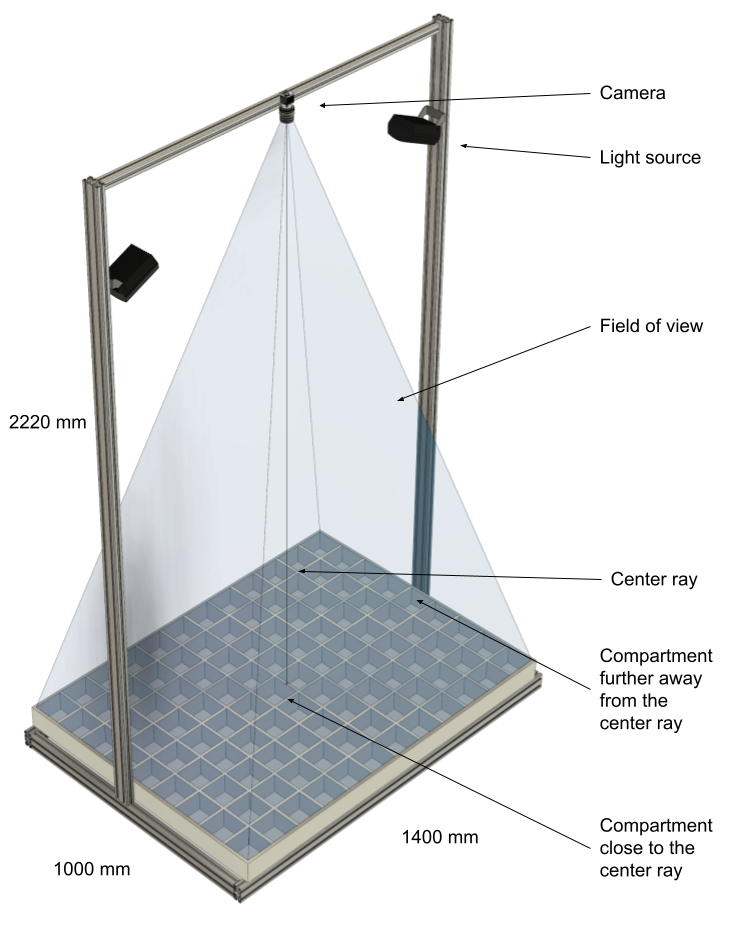 An example system with lighting (visual and/or near infrared) for recording 108 compartments.
An example system with lighting (visual and/or near infrared) for recording 108 compartments.
We recommend using our Motif recording software for reliable and versatile video recording.
The Challenge
The view of an overhead camera is obstructed by walls dividing the total area into compartments. The walls obstruct direct line of sight and cast a blind area. This problem exists at every scale - detection and tracking of subjects, be it very small C.elegans or much larger fish will not be possible in the obstructed area or volume.
 Blind spots will be present in all configurations where a single camera records many compartments
Blind spots will be present in all configurations where a single camera records many compartments
How to Minimize Blind Spots
The distance of the camera in relation to the width or diagonal of the area is the most important factor. The closer the camera is to the arena the more significant this effect will be. Positioning the camera at a greater distance from the compartments will reduce the size of the blind area. This is because the "Angle of view" is smaller and consequently the light rays become "more parallel" compared to the camera being close.
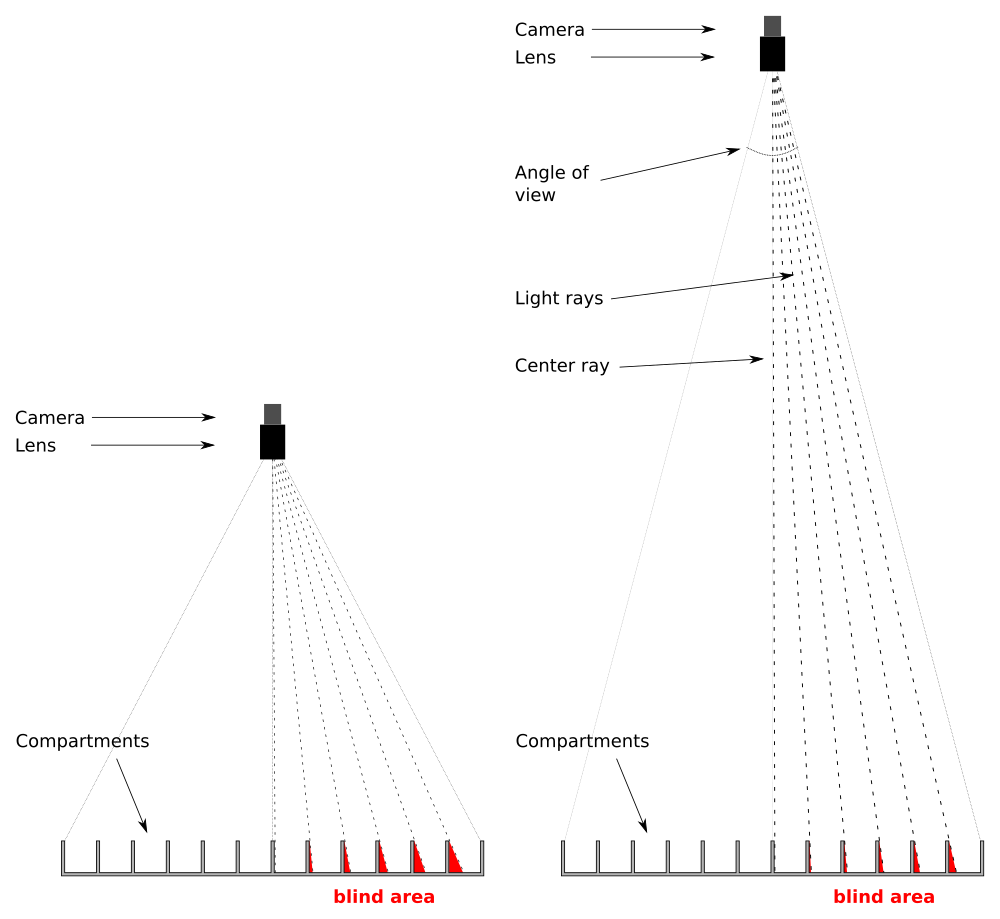 A comparison of camera-rays when mounted close to or far from the compartments. Cameras mounted close to compartments cast larger blind areas whereas cameras mounted further away from compartments reduces blind areas
A comparison of camera-rays when mounted close to or far from the compartments. Cameras mounted close to compartments cast larger blind areas whereas cameras mounted further away from compartments reduces blind areas
The second factor influencing the size of the blind area is the height of the walls. The higher the walls are the larger the blind area will be. Reducing the height of the walls separating the compartments will reduce the size of the blind area.
What If Distance and Compartment Height is Fixed?
Changing the wall height of a cell culture plate (multi-well plate) is possible but often not feasible. This is similarly true when working with larger off the shelf compartments for fish, mice, or similarly sized model organisms. Increasing the distance between the camera and the compartments might be limited by the height of the ceiling of the room, the height of the incubator, or maybe the height of the rack everything needs to fit into. Several options mitigate this limitation or eradicate it at all.
Using Multiple Cameras
Using multiple cameras, each with a smaller angle of view can be used for reducing the blind area significantly.
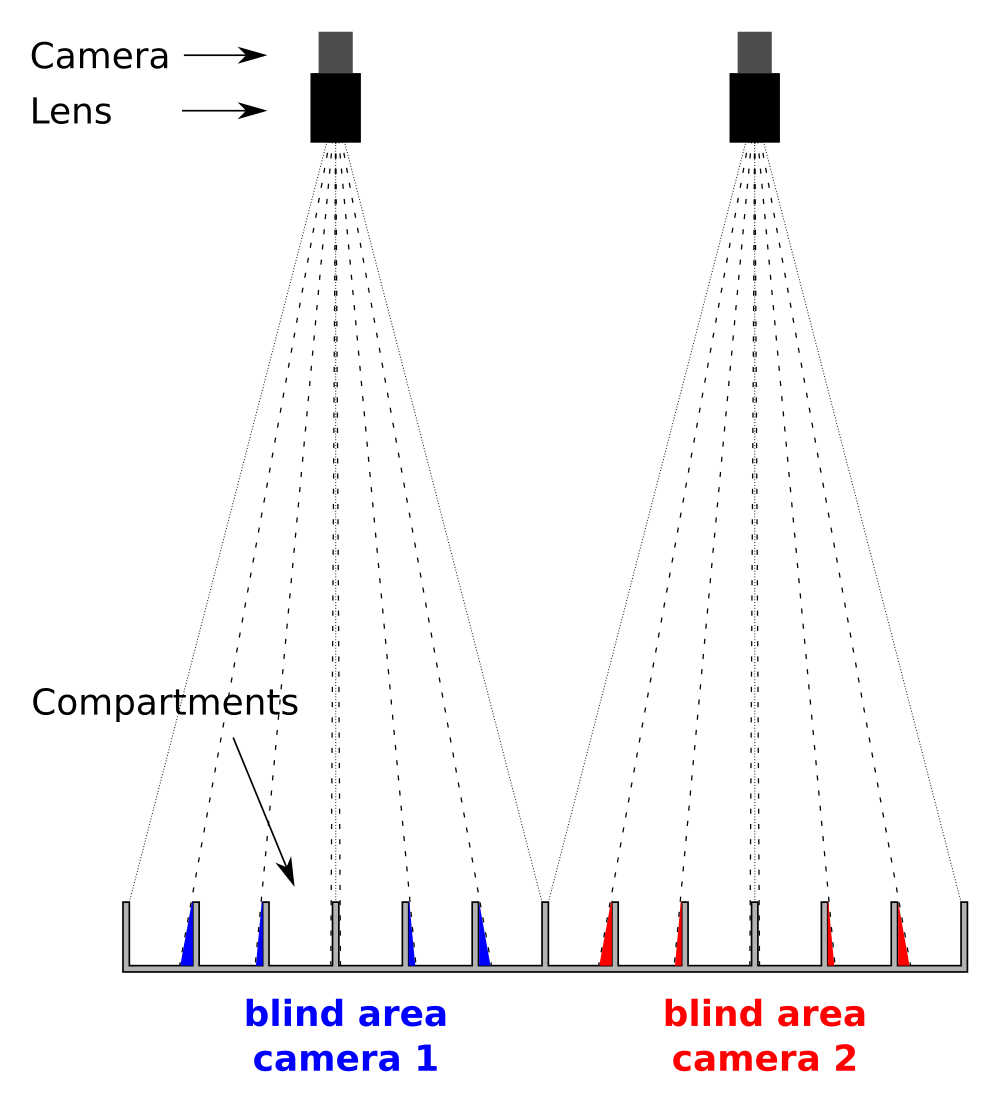 Multiple cameras viewing subsections of an arena reduces the size of the blind area and can be used for increasing spatial resolution and frame rate
Multiple cameras viewing subsections of an arena reduces the size of the blind area and can be used for increasing spatial resolution and frame rate
Increasing the number of cameras for a given area simultaneously reduces the blind area but also allows for increased spatial resolution and framerate.
Motif Recording Systems for multiple cameras are a common configuration.Kastl-HighRes (High Resolution Multiple-Camera System) is a good example of using multiple cameras (up to 6 cameras) for reducing the blind area in a multi-well plate configuration with an extremely high resolution of 75 to 100pixels per mm across the whole multiwell plate at up to 30 frames per second. For more information on systems of this nature please see our case study here.
A similar use of multi-camera arrays is to cover a larger area without compartments. This is a common application if either higher resolution and frame rates are required than what a single camera could provide, or if the height of a system is limited. Continue reading our case study about Video Recording of Fish Assays.
Increasing Camera Distance with Mirrors
One or multiple mirrors can be used for increasing the distance between the camera and the compartments even further. Using a good mirror - preferably a surface mirror - allows maintaining the quality of the image. Precise mounting of the mirror is of essential importance. If a mirror or the camera moves the perspective on the arena will move as well. Slight changes in the angles might result in a large effect.
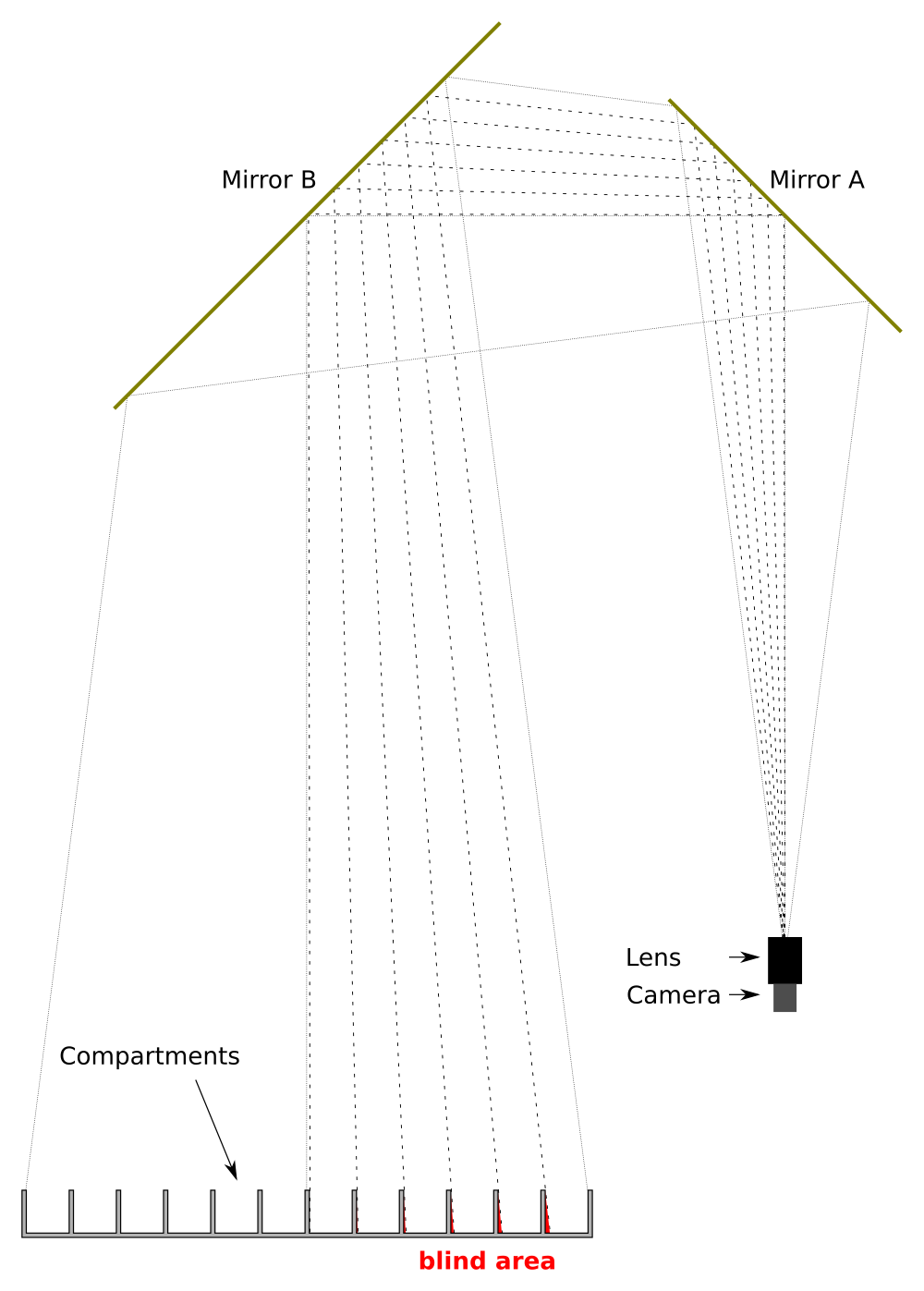 Increasing the distance between the compartments and the camera can be achieved with mirror arrangements
Increasing the distance between the compartments and the camera can be achieved with mirror arrangements
Collimation Lens
If the walls are relatively high, the space above the arena is limited or using multiple cameras is no option, an additional optical component, a collimator lens (fresnel lens) can be considered. Such a lens collects an orthographic view of the arena reducing or even eliminating blind spots.
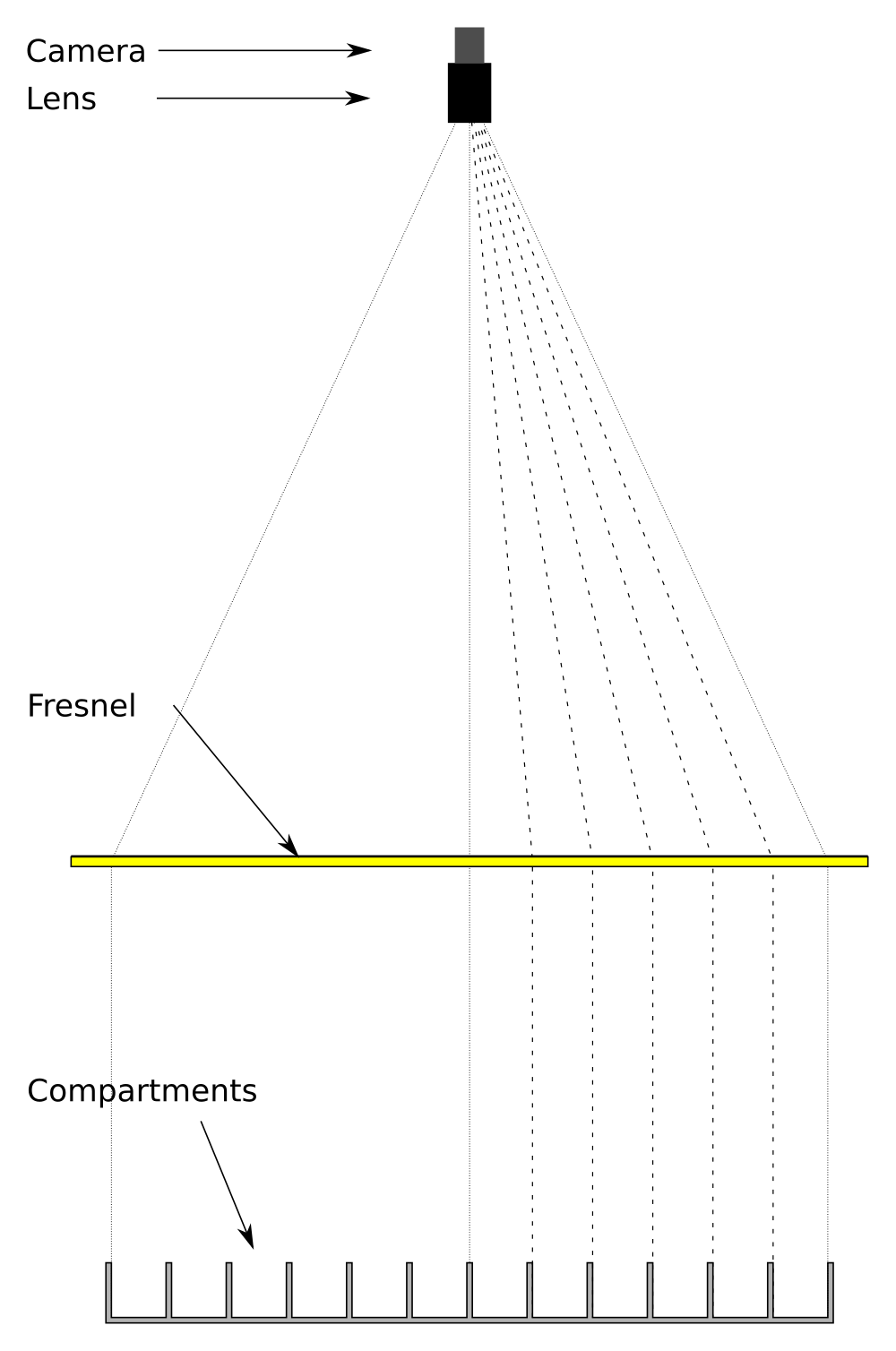
This arrangement can also remove perspective distortion that makes further objects appear visually smaller (e.g. a fish in a fish tank being at the surface or bottom of a tank will then have the same size in the image). Such lenses are quite thin (2-5mm), lightweight, and very cost-efficient.
A large disadvantage of such lenses is that they reduce the sharpness and resolution of the resulting image and are therefore not applicable for high-resolution applications. In addition direct lighting from the top will be harder to realize. For high-resolution applications, a telecentric lens (see below) could be an alternative.
Kastl Single-Camera Systems and the custom Kastl for fluorescent imageing make use of such fresnel lenses approach for allowing imaging 96well plates with a more compact form factor.
Loopbio has evaluated numerous collimation fresnel lenses available on the market and can suggest the best lens for your constraints. Through our relationship with fresnel lens manufacturers we can even provide custom lenses for your geometry. For more information and the maximal size of an arena please contact Loopbio
Telecentric Lens
Telecentric lenses only accept light rays parallel to the principal axis of the lens creating an orthographic view of the arena - an image without perspective distortion. This is similar to an arrangement with a fresnel lens (see "Collimation lens" above). Apart from their extraordinary visual quality, Telecentric lenses are quite heavy (up to several kilograms), physically large (the diameter needs to be larger than the diameter of the arena), and also very expensive (several thousand euros). Telecentric lenses work best with telecentric illumination.
 A representative telecentric lens attached to a camera captures an orthographic view of the arena.
A representative telecentric lens attached to a camera captures an orthographic view of the arena.
For example, to image an area of 2 multiwell plates (190x124mm) a telecentric lens with a length of 775mm and a mass of >20kg is required. The whole assembly measures would measure ~1340 mm in height. For imaging a single multiwell plate (124x84mm) a telecentric lens with a length of 430mm and a mass of >5.5kg would be necessary, the whole assembly would then measures ~1000 mm in height.
A Moving Camera
If the simultaneous recording of all compartments is not required one can consider moving the camera with a gantry system. Such a system, be it 1 or 2 axes, can move a single camera to multiple distinct positions. At each position, the camera can either take a single image or dwell for a given period for acquiring a video.
Motif supports easy configuration and control of automated recording patterns with its built-in API and web based user interface. The scheduling feature can be used to automatically image the compartments without user intervention.
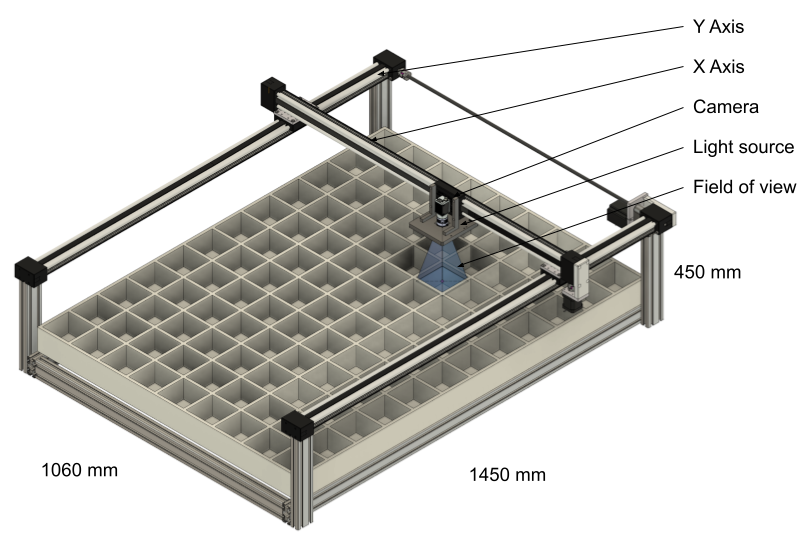 This XY gantry system can record from an area of 1330 x 900 mm and has a total height of ~450 mm. The camera can be moved to specific locations, or it can be controlled in a closed-loop fashion (e.g. for following a single subject). The light source, a thin LED panel, is fixed to the camera sled for achieving shadow-free illumination.
This XY gantry system can record from an area of 1330 x 900 mm and has a total height of ~450 mm. The camera can be moved to specific locations, or it can be controlled in a closed-loop fashion (e.g. for following a single subject). The light source, a thin LED panel, is fixed to the camera sled for achieving shadow-free illumination.
The area that can be covered with a gantry system reaches from a multi well-plate with super high resolution to a system that is up to 9sqm (3000 x 3000 mm) in size.